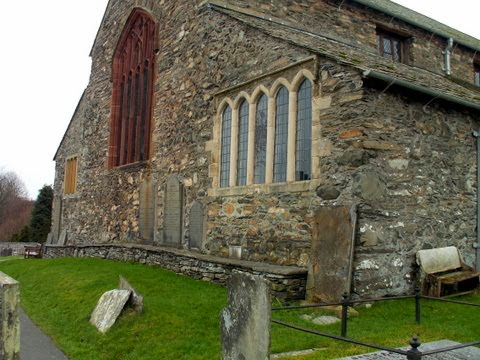The Rudston Monolith
Close to the east end of the
parish church of All Saints East Yorkshire is Rudston Monolith said to be
the tallest of all Britain
So what is it doing at this
location? Local tradition says that the
devil, angered by the building of a monument to his adversary, hurled this
stone javelin at the church. By divine
intervention his aim was deflected and the stone landed in its present position
deeply embedded in the ground.
On the other hand it may have
been left there by glacial action, it certainly was not local but is thought to
have originated several miles away on the coast at Cayton Bay Scarborough . Another theory is that it was erected by
Bronze Age men for some ritualistic purpose, being later adapted by early
Christians as a cross or ruud, thus giving the village its name.
The Ruud Stone
The Barmby Wart Stone
Another curious standing stone can be seen opposite the
church porch at Barmby Moor near Pocklington in East
Yorkshire . Just under five
feet in height this stone is known locally as ‘The Wart Stone’. Rain water sometimes gathers on the top of
the stone and local legend has it that this water is a certain cure for
warts. Although very little is known
about the stone, it would seem to be a prehistoric monolith, probably of some
religious or Pagan significance.
The Wart Stone
Hawksworth Church
This fine church at Hawksworth is on the 'Wordsworth' trail in the lake District - he went to school in the village and worshipped in this church. Although now stripped of its outside white paint, it is the church of which the poet wrote: 'I saw the snow-white church upon her hill, Sit like a throned lady sending out, A gracious look all over her domain'.
An unusual survivor can be seen outside the east wall of the church - its is a long stone bench known as 'Church End' where parishioners sat after services to hear public notices and became a general meeting place for the villager's. Quite a rarity.
The bagpiper and Old Tristram
A fine gargoyle in the shape of a bagpiper can be seen on the side of the Parish Church of St John the Baptist in Halifax.
The bagpiper
Inside the church is a strage old alms box which is the life size image of an old man with a long
beard and wearing a long coat and breeches. Known as Old Tristram, it is said to portray a beggar who was familiar on the streets of the town in the 17th
century.
Old Tristram
Peter’s Pence Lectern
A 15th century lectern in the church of St
John The Evangelist at Oxborough in
Norfolk is one of some fifty Peter’s
Pence Lectern’s in the country. They were so called because they were used to
collect a tax of one penny per household imposed by King Offa in AD787. The money, which was sent to Rome, was put in
a slot in the beak and recovered from a second slot in the tail
The church was built during the 14th century, replacing the much smaller church of St Mary Magdalen, the ruin > Link of which is situated about one kilometre to the south-west, and the stone doorways in the north porch and the west window of the north aisle may have come from this older church. In 1948 the tower and spire collapsed and fell into the church below > Link
of which is situated about one kilometre to the south-west, and the stone doorways in the north porch and the west window of the north aisle may have come from this older church. In 1948 the tower and spire collapsed and fell into the church below > Link leaving only the chancel and the Bedingford chapel - so named after the Lords of the Manor - intact. The chapel was built in the 15th century in about 1500 and houses rare terracotta monuments > Link
leaving only the chancel and the Bedingford chapel - so named after the Lords of the Manor - intact. The chapel was built in the 15th century in about 1500 and houses rare terracotta monuments > Link which many consider to be the best in all of England.
which many consider to be the best in all of England.
Oxborough Church
I am grateful to Evelyn Simak for the use of this Geograph photograph and text.







![Creative Commons Licence [Some Rights Reserved]](http://creativecommons.org/images/public/somerights20.gif)

No comments:
Post a Comment